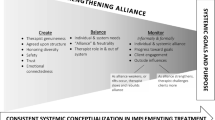Abstract
This study of 33 student therapists, 402 client systems, and three supervisors tested the efficacy of using student co-therapy teams as an aspect of clinical training in a marriage and family therapy program. This study utilizes both quantitative and qualitative methodology. Two research questions were addressed: “Do different pairings of co-therapists affect client outcomes?” and “Is co-therapy a viable option for a training program?” The results indicate that client outcomes using co-therapy are at least as effective as treatment using one therapist and in some circumstances produce more positive outcomes for both clients and student therapists.
Similar content being viewed by others
References
American Psychiatric Association (1994). Diagnostic and statistical manual of mental disorders (4th ed.). Washington, DC: American Psychiatric Association.
Baruth, L. G., & Huber, C. H. (1991). An introduction to marital theory and therapy. Prospect Heights, IL: Wavelength Press, Inc.
Bateson, G. (1979). Steps to an ecology of mind. San Francisco: Chandler.
Benjamin, L. R., & Benjamin, R. (1994). A group for partners and parents of MPD clients part I: Process and format. Dissociation, 7, 35–43.
Bernard, H. S., Babineau, R., & Schwartz, A. J. (1980). Supervisor-trainee cotherapy as a method for individual psychotherapy training. Psychiatry, 43, 138–145.
Bowers, W. A., & Gauron, E. F. (1981). Potential hazards of the co-therapy relationship. Psychotherapy: Theory, Research and Practice, 18, 225–228.
Brock, G. W., & Barnard, C. P. (1999). Procedures in marriage and family therapy. Needham Heights, MA: Allyn & Bacon.
De Luca, R., Boyes, D. A., Furer, P., Grayston, A. D., & Hiebert-Murphy, D. (1992). Group treatment for child sexual abuse. Canadian Psychology, 33, 168–179.
Haley, J. (1987). Problem-Solving Therapy (Second Ed.). San Francisco: Jossey-Bass.
Haley, J. (1996). Learning and teaching therapy. New York: Guilford Press.
Hannum, J. W. (1980). Some cotherapy techniques with families. Family Process, 19, 161–168.
Hoffman, S., Gafni, S., & Laub, B. (1994). Cotherapy with individuals, families, and groups. Northvale, NJ: Jason Aronson.
Latham, T. (1982). The use of co-working (co-therapy) as a training method. Journal of Family Therapy, 4, 257–269.
LoPiccolo, J., Heiman, J. R., Hogan, D. R., & Roberts, C. W. (1985). Effectiveness of single therapists versus cotherapy teams in sex therapy. Journal of Consulting and Clinical Psychology, 53, 287–294.
Masters, W. H., Johnson, V. E., & Kolodny, R. C. (1988). Sex and human loving. New York: Little, Brown, and Company.
Napier, A. Y., & Whitaker, C. (1978). The family crucible: The intense experience of family therapy. New York: Harper & Row.
Olson, D. H. (1989). Health and stress profile. Minneapolis, MN: Life Innovations, Inc.
Olson, D. H., Fournier, D., & Druckman, J. (1987). PREPARE ENRICH counselor's manual (Rev. ed.). Minneapolis, MN: REPARE/ENRICH, Inc.
Olson, D. H., McCubbin, H. I., Barnes, H., Larsen, A., Muxen, M., & Wilson, M. (1982). Family inventories: Inventories used in a national survey of families across the family life cycle. St. Paul, MN: University of Minnesota.
Olson, D. H., & Stewart, K. L. (1990). Multisystems assessments of health and stress (MASH) model and the Health and Stress Profile (HSP). Technical report available from Life Innovations, Minneapolis, MN.
Palazzoli, M. S., Boscolo, L., Cecchin, G., & Prata, G. (1990). Paradox and counterparadox: A new model in the therapy of the family in schizophrenic transaction. Northvale, NJ: Jason Aronson.
Russell, A., & Russell, L. (1980). Uses and abuses of co-therapy. In J. G. Howells (Ed.), Advances in Family Psychiatry, Volume II (pp. 401–410). New York: International Universities Press, Inc.
Sager, C. J. (1968). An overview of family therapy. International Journal of Group Psychotherapy, 18, 32.
Selvini, M., & Palazzoli, M. S. (1991). Team consultation: an indispensable tool for the progress of knowledge. Ways of fostering and promoting its creative potential. Journal of Family Therapy, 13, 31–52.
Turner, J., & Fine, M. (1997). Gender and supervision: Evolving debates. In T. C. Todd & C. L. Storm (Eds.), The complete systemic supervisor (pp. 72–82). Needham Heights, MA: Allyn and Bacon.
Author information
Authors and Affiliations
Rights and permissions
About this article
Cite this article
Hendrix, C.C., Fournier, D.G. & Briggs, K. Impact of Co-Therapy Teams on Client Outcomes and Therapist Training in Marriage and Family Therapy. Contemporary Family Therapy 23, 63–82 (2001). https://doi.org/10.1023/A:1007824216363
Issue Date:
DOI: https://doi.org/10.1023/A:1007824216363




